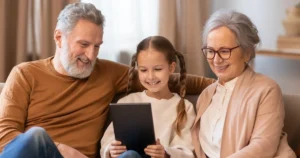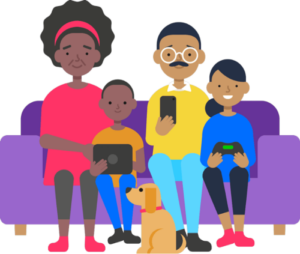If you’re thinking of buying your child a Kindle eBook, Rik Henderson of Pocket-lint has some great tips on how to set it up before you hand your child their new gadget.
Why use Amazon Kindle e-reader?
Amazon’s Kindle eBook reader has plenty of features ideal for younger readers.
For a start, you can buy and download large amounts of books to read to or with your children. And as they get older, they can use the device to buy and download their own titles, all without taking up space on shelves.
How do you set up a Kindle for your child?
Setting up a Kindle for a child is sometimes confusing. Or you might just not know what’s involved.
That’s why we’ve put together this handy guide on what to consider when presenting an Amazon Kindle reading device to your children for the first time.
Here we’re talking specifically about Kindle eBook readers, rather than Fire tablets. However, the same information applies in many cases.
Register an account
A Kindle needs to be registered to an Amazon account.
If you’re getting a new Kindle specifically for a child, then you need to decide whether you’re going have it linked to their own Amazon account, or to your account.
If the child/Kindle gets its own account, then that account needs an email address, as well as a payment method. You don’t want to hand over your credit card, so using a pre-paid card to setup the Amazon account is an option.
Using this means, you can have a small value for some initial book purchases without having to worry about them emptying your bank account. You can always top up that pre-paid card for future purchases.
If you opt to have the Kindle on your account (or have a child use your Kindle), then you’ll have to make sure you use parental controls to ensure they don’t spend on your account, or use Amazon Kids.
Parental controls
Kindle has plenty of parental controls, which is good place to start. If you’re giving your child a Kindle, you can opt to close off the major access points to the internet: web browser, Kindle Store and Cloud.
Each of these can be disabled, with parental controls getting password protection. That means you can, for example, disable the web browser and Kindle Store on that device, but leave access to Cloud. Cloud is where your Kindle purchases are stored when not downloaded to a device – it’s your complete online catalogue of content.
You can shut everything off, so you know that your child only has access to the content on the device and can’t go exploring. The Kindle is still connected to the internet, there just aren’t any access points from the device.
This is a better option that simply turning on Aeroplane mode, because books will still sync, and importantly, you can still send books to the Kindle from the Kindle Store on your computer’s browser. You can also send documents to the Kindle using the email address assigned to your Kindle device, for example coursework packs from school.
This means you can put the Kindle in the hands of your child and buy books and have them delivered to their device to read. They will just appear on the home page.
What is Amazon Kids?
Amazon Kids is a system for children that replaced Kindle FreeTime and works across Amazon devices. This is, essentially, a locked down area specifically for them. Using Amazon Kids means you can have “your” adult/parental side of the device fully connected and “their” side safely locked down with only their content.
For Kindle, Amazon Kids lets you setup a child (or number of children) and then assign books to them from your collection. Using Amazon Kids means you’re buying those books on your account and sharing them, rather than buying them through an Amazon account in your child’s name.
From within Amazon Kids, the navigation controls work very much as they do elsewhere, so you can still go home, search, and change some settings, but it’s all behind that safety barrier. There are awards and you have a reading target to encourage children to read regularly.
Progress through books will also be tracked separately from your reading. If you both want to read The Hobbit, for example, your child’s progress will be tracked separately from yours. If you simply used the same account and were reading the same book, it would be constantly trying to sync that book to the furthest read page, which isn’t ideal when two separate people are reading it.
Importantly, unlike locking down a device with parental control settings above, you still have to assign that content to Amazon Kids for your child. This can be done on the device itself or through a browser, so you can easily buy books and assign them to children, but it’s a deliberate action.
Households and Family Library
Family Library is a Kindle feature that lets you share content with family members. It’s a convenient way for you to share or manage the content you have and you only have to buy things once.
To have a Family Library, you need to create a Household. This can consist of two adults, each with their own Amazon account, and up to four children. These child accounts are setup using Amazon Kids.
As a Household can’t accept more than two Amazon accounts (notionally two parents) it is a disadvantage to have a child’s Kindle with its own Amazon account, as that third account can’t be accommodated and you can’t share content through the Family Library. (Of course not all Households will have two parents, or might not have two parents who want to share content.)
However, once you have a Family Library setup, the two adult accounts can manage the content the children get access to. That means one adult can buy the content and the other can add or remove it from their own account if they need to.
Once you have adults and children in a Household, it’s really easy to manage content through a browser. In your account settings got to Manage Your Content and Devices you can see all your Kindle books and who in your household gets access to them.
What’s the best child Kindle setup?
The range of options and approaches means that settings can be tailored to the age of your child and how much autonomy you want them to have. For the younger children, you’ll want their Kindle registered to your Amazon account, but with all the parental controls engaged, so there’s no access to your account, Cloud or the web browser.
Then you’ll want to use Amazon Kids for that child. If they are getting their “own” Kindle device, you can then remotely control the content they get access to. You can gift books by simply buying them and assigning them to their Kids account.
You remain in control of content at all times and can easily remove books that they’ve finished with or outgrown. Importantly, if you’re buying it through your account, it’s your content and you can then share it with younger members of the family. Equally, as a child grows older, using a Household, you can still share older content in the future you might have bought for yourself.






